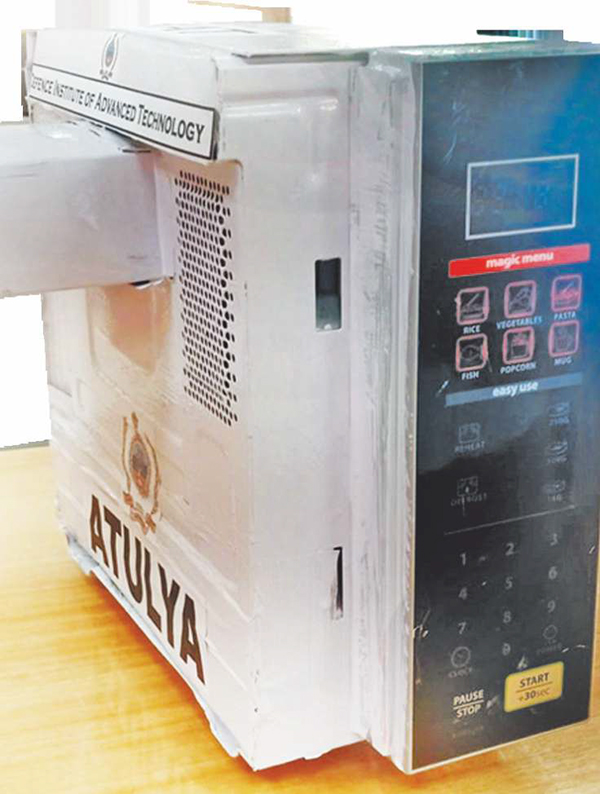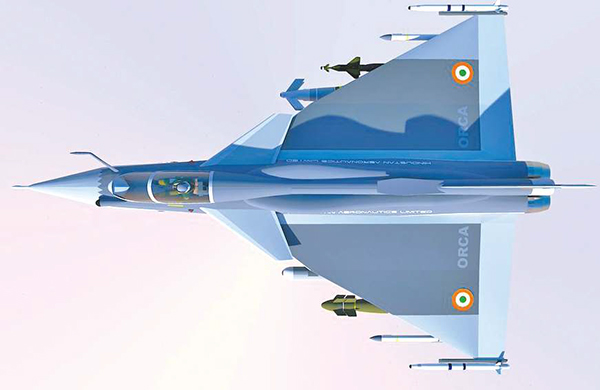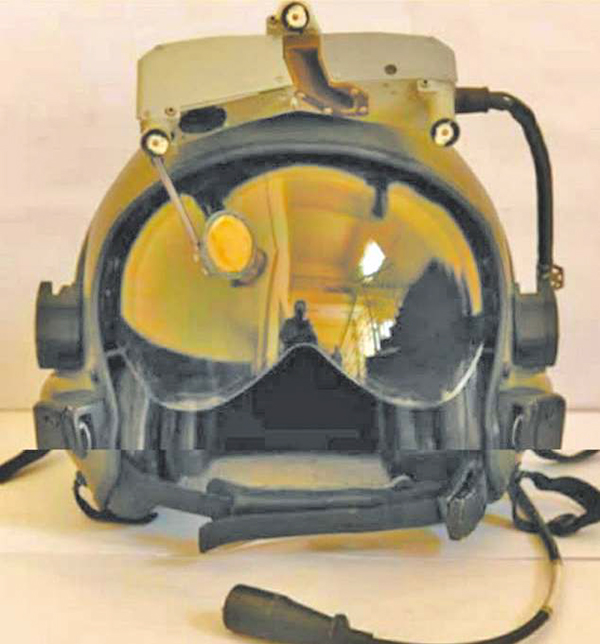First Glimpse of Omni Role Combat Aircraft
The first rendering of the twin-engined Omni Role Combat Aircraft (ORCA), sometimes called the Medium Combat Aircraft, was revealed by Harsh Vardhan Thakur, Test Pilot with HAL from his Twitter account. ORCA is the idea behind the twin-engine Tejas Mk.2. This has raised many speculative questions.
The advantages of a twin-engine design are many. First, it will have increased speed and maneuverability, the jet will have enhanced range because it can carry more fuel and with refueling, it can be extended to well over 2000 km. It can carry larger combat loads. It is also less susceptible to mechanical failures or combat damage. It can carry larger combat loads. At high altitudes, using two engines will have tremendous supplemental benefits, as losing a single engine jet over water or land is a much more life-threatening experience. System redundancy is a tertiary benefit of multi-engine aircraft, since losing engine results in only a 50% loss in total available thrust, plus redundant generators and hydraulic pumps will allow the aircraft to fly. In addition, having two engines will reduce training losses.
The IAF needs 45 squadrons which should consist of a good mix of heavy, medium and light aircraft. The Sukhoi Su-30MKI is the heavy aircraft and is supposed to reach a total number of 272 which would comprise of 15 squadrons. The Rafale and MiG-29 would be the medium jets for about 8-10 squadrons. Then a single engine fighter including 60 Mirage-2000 and new Tejas Mk-II would be the light aircraft and should be some 20 squadrons in total. This last category includes the MiG-21 and MiG-27 which will be phased out in the next few years. So the need is urgent, to say the least.
Tejas has provided Indian engineers valuable knowledge and experience to design and build a cutting-edge contemporary fighter, the long gestation period taken to develop the Tejas will come in handy when designing and manufacturing the twin-engine jet.
Light-weight HMDS Helmet for IAF
DRDO has developed a new lightweight integrated helmet to be used by Indian Air Force (IAF) pilots, flying the country’s front-line fighters such as Sukhoi 30-MKI, Mig-29, Mirage 2000 and also Russian made vintage MiG-21 Bisons.
“The integrated helmet-mask assembly has been designed to primarily incorporate Helmet Mounted Display and Sight (HMDS) as per the user requirement,” DRDO said in a statement. The helmets were subjected to open jet wind blast test at 600 KEAS at DGA, CEAT, France as per the parameters specified in MiL 29591/1(AS).
The integrated helmet with internally retractable dual polycarbonate visor system and pressure breathing oxygen mask has been developed by Defence Bio-Engineering & Electro Medical Laboratory (DEBEL), Bangalore.
The development of an indigenous HMDS display for fighter pilots will help the country to save precious forex reserves through import substitution.
The helmet-mask assembly was subjected to eight different profiles and has successfully withstood all the tests thereby proving the integrity of helmet-mask assembly during ejection.
Beyond-Visual-Range Drone Tested
The Army successfully tested an indigenous UAV, on 16 April, for autonomous delivery of load over Punjab. The test was carried out for delivery of Covid-19 items. The test proved an ability to operate at far-off ranges, at beyond visual line of sight, meaning the drone was remotely controlled either by a radar or another bigger UAV above it, and possibly the payload the drone could carry.
Three domestic drones were tested over Gobindgarh, Balluana, Malukpura villages around Abohar in Fazilka district of Punjab, located at distance of up to 25 km from the launch point and beyond visual line of sight from base. The task was ‘anti-Covid’ operations and to deliver essential supplies, including masks, liquid-sanitiser and medical canisters.
The Army coordinated these tests with the district administration, it is clear such operations can be on a large scale by increasing the number of drones and enhancing the endurance and payload of each drone. The Army uses a few bigger drones for surveillance.
The drones were flown over the earmarked dropping zone, made to descend to a suitable height and release its payloads.
UV Disinfection Tower
DRDO has developed an ultra violet (UV) disinfection tower for rapid and chemical-free disinfection of high infection-prone areas. The device is also effective for areas with large flow of people such as airports, shopping malls, metros, hotels, factories, offices, etc.
The equipment named UV Blaster is “useful for high tech surfaces like electronic equipment, computers and other gadgets in laboratories and offices that are not suitable for disinfection with chemical methods. The product is also effective for areas with large flow of people such as airports, shopping malls, metros, hotels, factories and offices,” a DRDO statement said.
It was designed and developed by Laser Science & Technology Centre (LASTEC) based in Delhi with the help of New Age Instruments and Materials Private Limited, Gurugram.
For a room of about 12×12 feet dimension, the disinfection time is about 10 minutes, while for a 400 square feet area, it would take 30 minutes by positioning the equipment at different places within the room, the statement said, adding that the sanitiser could be remotely operated.
Hitting Enemy Targets Without Positioning Error
In a major development that could have a wider impact, ranging from accurate aiming on enemy targets to scientific research in space weather, scientists from the Indian Institute of Geomagnetism (IIG), have developed a global model to predict ionospheric electron density with larger data coverage.
The ionosphere is a major source of error in GPS/GNSS-based positioning and navigation networks. Due to the unavailability of a reliable model to predict the electron density of the ionosphere, navigation errors remain, creating technological hurdles. A new model developed by Indian researchers has potential applications in calculating these Global Navigation Satellite System (GNSS) positioning errors.
Named as an ‘Artificial Neural Networks-based global Ionospheric Model’ (ANNIM), the development uses long-term ionospheric observations to predict electron density and peak parameters of the ionised part of the Earth’s upper atmosphere, between 46-621 miles above the surface. The model successfully reproduced large-scale anomalies in the ionosphere caused by solar and cosmic radiation.
Although several fighter jet and other missile systems have been fitted with highly-accurate navigation systems, few weapons in service can yet take advantage of this model.
ANNIM replicates the processes the human brain uses to solve problems including pattern recognition, classification, clustering, generalization, linear and nonlinear data fitting, and time-series predictions. Very few attempts have been made to model global ionosphere variability using ANNIMs.




















